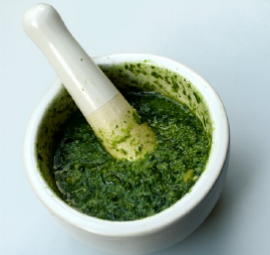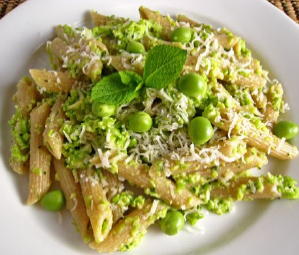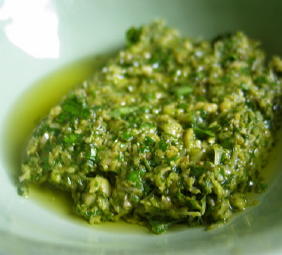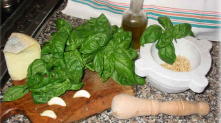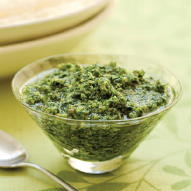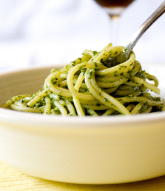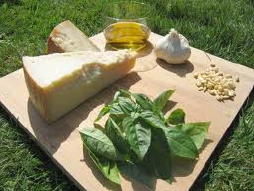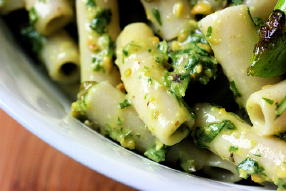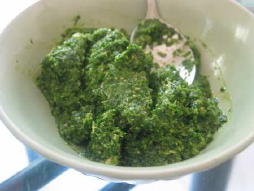"You're only here for a
short visit. Don't hurry. Don't worry. |
|||||||||||
|
First a confession. For over twenty years, I celebrated Basil Pesto. I sang its attributes in cookbooks, made massive quantities of it for The Silver Palate store, featured it in SP products, and on countless occasions have given it the starring role in summertime alfresco dinner party menus. During all of that time, I must admit, I made it only for others, never for me. While I love most foods (with the exception of okra and green pepper), the fuss about Basil Pesto simply eluded me. That all changed , however a little over a decade ago, when on a visit in Genoa our departure port for a Christmas cruise with "The Mothers" to seventeen ports in the Mediterranean, we quickly grabbed a bite at the cavernous restaurant nestled next to the ship. We all ordered the expeditious Pesto Lasagna. When it arrived, before me sat a huge pale green square that looked helplessly weak. With, my first bite, the lasagnaís flavors exploded in my mouth. While sitting in my chair I did one of my little dances I do when I really love the taste of something. WOW! What was this? Could this possibly be the pesto Iíd ignored for all of these years? Of course I knew that Pesto was a sauce that originated in Liguria and here we were in Genoa, its largest city. I also long knew that the name meant "to pound, bruise or crush" from the Latin root word "pestare," but what was this ethereal pesto that I was tasting, as if for the first time? Once home, after many fabulous meals in Casablanca, Fez, Tunisia, Madeira, Malta Barcelona, Sicily, Gibraltar, The Canary Islands, Rome, Nice, Venice and at sea, I simply couldnít get the flavor of that simple Pesto Lasagna from Genoa out of my mind. I decided to chase that taste. Of course I knew that I was up against centuries of Italian tradition plus pure heirloom Genovese basil, olive oil, probably only six weeks old, garlic grown at a local nearby farm and possibly even handmade fresh pasta - all contributing to the extraordinary flavor of that Pesto Lasagna now so firmly embedded in my mind.
I've often said I cook in my head first then in the kitchen. I also know that the simpler the recipe, the more critical it is to have superb ingredients. But here I was in a small village in Michigan surrounded by mountains of winter snow. No Genovese basil here. I decided to focus on the "to pound or to crush" part of Pestoís lineage. Luckily I had a mortar and pestle, that ancient tool that has been left unimproved by modern technology, which Iíd "schlepped" home from the South of France years before. Made of beautiful olive wood, I had always thought of it as more of a kitchen sculpture than a piece of equipment. In it, I crushed and pounded my usual Pesto recipe (however, with no walnuts on hand, my normal nut of choice, I substituted hazelnuts, toasted of course). Awkwardly handling the pestle as if it were a baseball bat, I struggled to incorporate all of the ingredients, gradually pounding them into a still slightly chunky paste. I stuck my finger in for a taste. Instantly I did my little dance! Could the hazelnuts have made such a difference?
I decided to make another batch using my regular food processor method and the hazelnuts. Tasted side by side there was absolutely no comparison! One was the familiar smooth green glob Iíd ignored for years. The other, made with the same mortar and pestle used by the Romans, was slightly chunky with an uneven texture. It tasted of each of its ingredients, intense and simultaneously clear and complex, yet loaded with nuance and sunshine. Its flavors sparkled! It was superb! I vowed to always make pesto this way and to eat it every day for the rest of my life. I implore you to do the same.
From that day on using my mortar and pestle has become an intricate part of my cooking. It is used almost daily for making all sorts of things; various kinds of pesto, crushing spices and seeds, aioli, mayonnaise, gremolata, smashing olives, grinding nuts, anchovies, or capers ... well, you get my drift. Of course there is no end to the kinds of "Pesto" one can make ... using basil, parsley, tarragon, arugula, cilantro, mint, sage, sorrel, dill, sun dried tomatoes, capers, broccoli, olives, peas, artichokes, pistachios, red peppers, mushrooms, spinach, roasted garlic, or smoothing beans of all kinds. The only limit is your imagination. Nor, for the ways that it can make simple dishes absolutely sing by combining it with potatoes, fish, sandwiches, tomatoes, eggplant, pasta, pizza, rice and grains, breads, poultry, stews, soups, or to jazz up just about any vegetable.
|
|||||||||||
